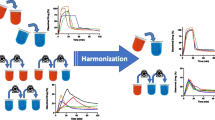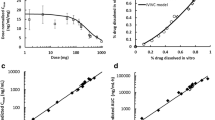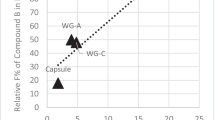ABSTRACT
In the past two decades, in vitro in vivo correlation (IVIVC) has been considered an important tool for supporting biowaivers, setting dissolution acceptance criteria, and more recently in the Quality by Design (QbD) framework promoting the establishment of clinically meaningful drug product specifications using dissolution as the endpoint. Based on our review experience at the FDA, for the purposes of this article, we analyzed the current state of regulatory submissions containing IVIVC approaches and discussed the successes and failures from the perspectives of study design to methodology. In the past decade, the overall acceptance rate of the IVIVC submissions is about 40%. Moreover, the number of IVIVC studies seen in the submissions per year is not increasing. Establishing clinically meaningful drug product specifications through the linkages between the identified critical quality attributes and in vivo performance is key for developing a quality drug product. To achieve this goal, there is an imminent need for addressing the issues behind a low success rate in IVIVC development. The results from the current analysis revealed that special considerations should be taken in areas such as (1) selection of appropriate number/kind of formulations for IVIVC development/validation, (2) construction of exploratory plots to guide model building and selection, (3) investigation of the reasons of inconclusive predictability, (4) improvement on the quality and richness of the data, and (5) avoidance of over parameterization. The development and incorporation of biopredictive dissolution methods and the use of non-conventional approaches, including mechanistic/physiologically based approaches, should be explored to increase the likelihood of IVIVC success.






Similar content being viewed by others
REFERENCES
Cardot JM, Beyssac E. In vitro/in vivo correlations: scientific implications and standardisation. Eur J Drug Metab Pharmacokinet. 1993;18(1):113–20.
Emami J. In vitro–in vivo correlation: from theory to applications. J Pharm Pharm Sci Publ Can Soc Pharm Sci Soc Can Sci Pharm. 2006;9(2):169–89.
Skelley JP, Amidon GL, Barr WH, Benet LZ, Carter JE, Robinson JR, et al. Report of the workshop on in vitro and in vivo testing and correlation for oral controlled/modified-release dosage forms. J Pharm Sci. 1990;79(9):849–54.
Van Buskirk GA, Shah V, Yacobi A, Bolger MB, Chittenden J, Davit BM, et al. PQRI workshop report: application of IVIVC in formulation development. Dissolut Technol. 2014;21(2):51–8.
Suarez SS. Speaker and moderator at the PQRI Workshop Co-sponsored with FDA, AAPS, USP, and FIP. Title of presentation: FDA’s experience on IVIVC-new drug products. Rockville, MD. 2012. http://pqri.org/wp-content/uploads/2015/08/pdf/Suarez.pdf.
Guidance for Industry Extended Release Oral Dosage Forms: Development, Evaluation, and Application of In Vitro/In Vivo Correlations. In: FDA, editor. 1997.
Rathore AS, Winkle H. Quality by design for biopharmaceuticals. Nat Biotechnol. 2009;27(1):26–34. doi:10.1038/nbt0109-26.
Selen A, Cruanes MT, Mullertz A, Dickinson PA, Cook JA, Polli JE, et al. Meeting report: applied biopharmaceutics and quality by design for dissolution/release specification setting: product quality for patient benefit. AAPS J. 2010;12(3):465–72. doi:10.1208/s12248-010-9206-0.
Cardot JM, Davit BM. In vitro-in vivo correlations: tricks and traps. AAPS J. 2012;14(3):491–9. doi:10.1208/s12248-012-9359-0.
Buchwald P. Direct, differential-equation-based in-vitro-in-vivo correlation (IVIVC) method. J Pharm Pharmacol. 2003;55(4):495–504. doi:10.1211/002235702847.
Gaynor C, Dunne A, Davis J. A comparison of the prediction accuracy of two IVIVC modelling techniques. J Pharm Sci. 2008;97(8):3422–32. doi:10.1002/jps.21220.
Gillespie WR. Convolution-based approaches for in vivo-in vitro correlation modeling. Adv Exp Med Biol. 1997;423:53–65.
Kostewicz ES, Aarons L, Bergstrand M, Bolger MB, Galetin A, Hatley O, et al. PBPK models for the prediction of in vivo performance of oral dosage forms. Eur J Pharm Sci Off J Eur Fed Pharm Sci. 2014;57:300–21. doi:10.1016/j.ejps.2013.09.008.
Loo JC, Riegelman S. New method for calculating the intrinsic absorption rate of drugs. J Pharm Sci. 1968;57(6):918–28.
Otsuka K, Shono Y, Dressman J. Coupling biorelevant dissolution methods with physiologically based pharmacokinetic modelling to forecast in-vivo performance of solid oral dosage forms. J Pharm Pharmacol. 2013;65(7):937–52. doi:10.1111/jphp.12059.
Vaughan DP. A model independent method for estimating the in vivo release rate constant of a drug from its oral formulations. J Pharm Pharmacol. 1976;28(6):505–7.
Vaughan DP, Dennis M. Mathematical basis of point-area deconvolution method for determining in vivo input functions. J Pharm Sci. 1978;67(5):663–5.
Wagner JG, Ganes DA, Midha KK, Gonzalez-Younes I, Sackellares JC, Olson LD, et al. Stepwise determination of multicompartment disposition and absorption parameters from extravascular concentration-time data. Application to mesoridazine, flurbiprofen, flunarizine, labetalol, and diazepam. J Pharmacokinet Biopharm. 1991;19(4):413–55.
Wagner JG, Nelson E. Percent absorbed time plots derived from blood level and/or urinary excretion data. J Pharm Sci. 1963;52:610–1.
Zhang X, Lionberger RA, Davit BM, Yu LX. Utility of physiologically based absorption modeling in implementing Quality by Design in drug development. AAPS J. 2011;13(1):59–71. doi:10.1208/s12248-010-9250-9.
Ostrowski M, Wilkowska E, Baczek T. The influence of averaging procedure on the accuracy of IVIVC predictions: immediate release dosage form case study. J Pharm Sci. 2010;99(12):5040–5. doi:10.1002/jps.22209.
Jiang W, Kim S, Zhang X, Lionberger RA, Davit BM, Conner DP, et al. The role of predictive biopharmaceutical modeling and simulation in drug development and regulatory evaluation. Int J Pharm. 2011;418(2):151–60. doi:10.1016/j.ijpharm.2011.07.024.
Author information
Authors and Affiliations
Corresponding author
Ethics declarations
Conflict of Interest
There are no conflicts of interest to declare.
Disclaimer
This article reflects the views of the authors and should not be construed to represent FDA’s views or policies.
Additional information
Guest Editors: Amin Rostami Hodjegan and Marilyn N. Martinez
Rights and permissions
About this article
Cite this article
Suarez-Sharp, S., Li, M., Duan, J. et al. Regulatory Experience with In Vivo In Vitro Correlations (IVIVC) in New Drug Applications. AAPS J 18, 1379–1390 (2016). https://doi.org/10.1208/s12248-016-9966-2
Received:
Accepted:
Published:
Issue Date:
DOI: https://doi.org/10.1208/s12248-016-9966-2




